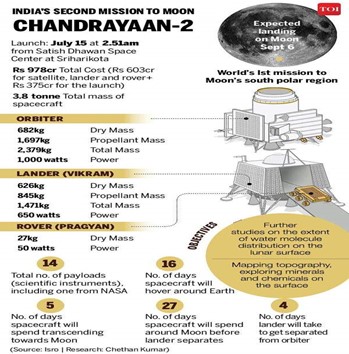PREVIOUS
Chandrayaan Missions of India – Part 3
August 29 , 2023
598 days
1941
0
(இதன் தமிழ் வடிவத்திற்கு இங்கே சொடுக்கவும்)
Chandrayaan 2
Importance and Benefits of the Mission
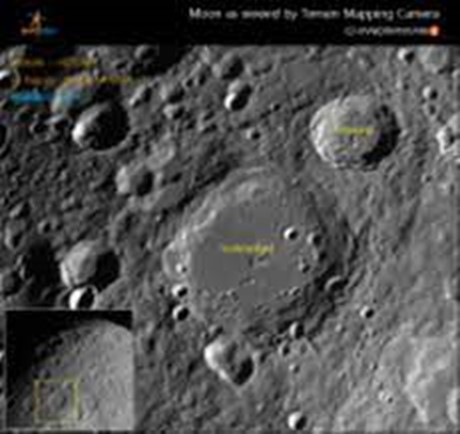
- The mission offers a pristine environment to study of moon.
- It is also closer than other celestial bodies.
- It aims the understanding of how celestial bodies are formed and evolved.
- It can help us better understand the solar system and even earth.
- With space travel taking shape, the exoplanets are being discovered every day.
- It is help to learn more about earth’s celestial neighbor.
- It can help in the advanced missions.
- India would be the 4th nation to reach the Moon.
- It boosts national pride in the citizens of India.
- It will boost the morale of scientists and research academicians.
- Also, it can motivate the youth to develop scientific temper.
- It will undertake real-life applications of science and technology.
- High precision components are used in the mission require high standards of manufacturing procedures.
- It is critical for imbibing the spirit of innovation in Indian manufacturing industry.
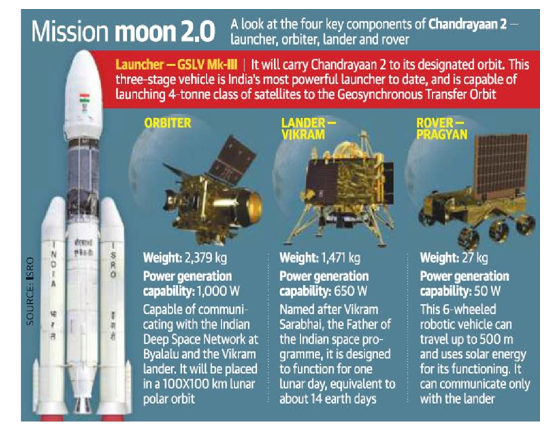
- ISRO initially partnered with a startup-Team Indus for the launch.
- Team Indus is a private Bengaluru-based company.
- Still, it gave a boost to the Indian startup industry in space sector thereby promoting entrepreneurship.
- Chandrayaan-2 offers similar possibilities.
- For Chandrayaan-2 mission, two women - Ritu Kridhal and M Vanitha are leading as project and mission directors respectively.
- Thus, it is a symbol of women empowerment.
- It is an icon of women taking leadership roles in the country's biggest projects.
Way Forward
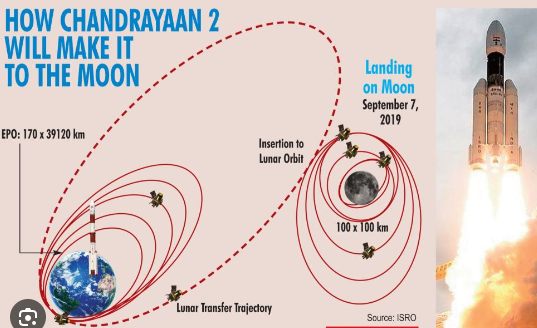
- The Chandrayaan-2 mission is a precursor to other ambitious missions like:
- The Gaganyaan project, which aims to place three Indians in space by 2022.
- Interplanetary probes and a solar spacecraft mission (Aditya-L1).
- Permanent space station in line with the International Space Station.
- India is already in talks with Japan’s JAXA (Japan Aerospace Exploration Agency) for a future mission Chandrayaan-3 in 2024.
- It aims to bring back soil and rock samples from the South Pole of the Moon.
- ISRO’s previous missions had several applications in different domains like telecommunication, military, remote-sensing, etc.
- Its future missions are expected to further explore new areas in deep space technology.
- Moon is the perfect test-bed for proving technologies required for future space exploration.
- If the future missions are successful in extracting water from the Moon, then it will pave the way for colonization of the Moon.
- Water will not only help in sustaining life on Moon.
- It can also provide Hydrogen and Oxygen to be used as fuel for interplanetary missions, particularly to Mars.
- Humanity is currently facing challenges like global warming, population explosion and shrinking of resources.
- Thus, mission programmes like Chandrayaan show the capability of Indian scientists.
- It aims to protect the interest of mankind and future generations by providing viable alternatives to life.
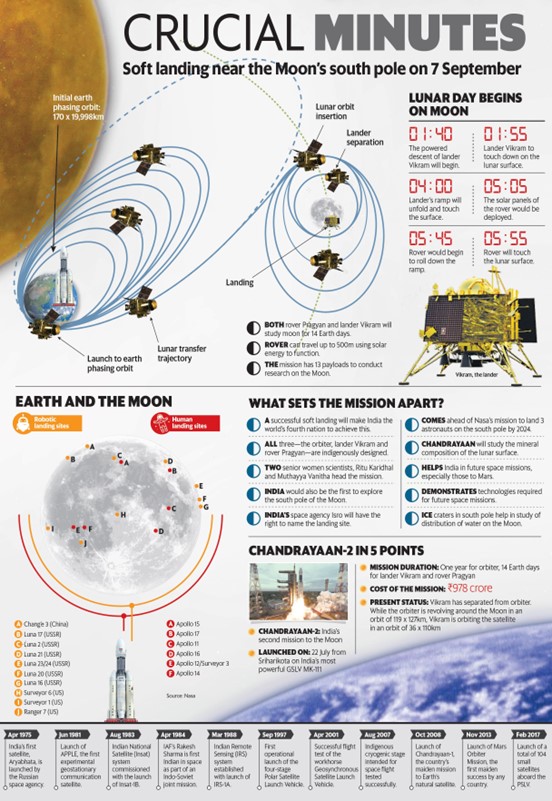
Highlights of Chandrayaan 2
- Chandrayaan 2 fostered the findings of Chandrayaan 1 as reported by the ISRO.
- The mission targeted the “South Polar region” of the Moon which was completely unexplored.
- The mission focused on the extensive mapping of the lunar surface for studying variations.
- In all the space missions, no country has ever attempted to land a spacecraft in the polar regions of the moon.
- This gave India a lead in space exploration on an international level.
- Due to the moon’s axis, few regions on the South Pole always remain dark.
- The craters might have never received sunlight because it at very low angles in the Polar Regions.
- Thus, it increased the chances of presence of ice on such surfaces.
- The lunar surface area at the south pole of the Moon remains in shadow.
- It is much larger than the North Pole thus making moon’s South Pole will be interesting.
- This also increases the probability of the existence of water in permanently shadowed areas around it.
- It was performed successfully today on September 04, 2019, beginning at 03:42 hrs IST.
- It was planned using the onboard propulsion system.
- The duration of the manoeuvres was 9 seconds.
- On October 14, 2019, Chandrayaan-2 detected the presence of Argon-40 in the lunar exosphere.
- On July 30th, 2020 Chandrayaan-2 imaged the Sarabhai Crater located on the north-east quadrant of the moon.
Information gathered by Chandrayaan 2
Presence of water molecules on moon
- The mission has given the most precise information about the presence of H2O molecules on the Moon till date.
Presence of Minor elements
- Chromium, manganese and Sodium have been detected for the first time through remote sensing.
- The finding can lay the path for understanding magmatic evolution on the Moon.
- It gives deeper insights into the nebular conditions as well as planetary differentiation.
Information about solar flares
- A large number of microflares outside the active region have been observed for the first time.
- According to ISRO, this “has great implications on the understanding of the mechanism behind heating of the solar corona”.
- It has been an open problem for many decades.
Components of Chandrayaan – 2: Launch Vehicle
- Boosters (Stage 0) - S-200
- First Stage - L-110 liquid state
- Second Stage - C-25
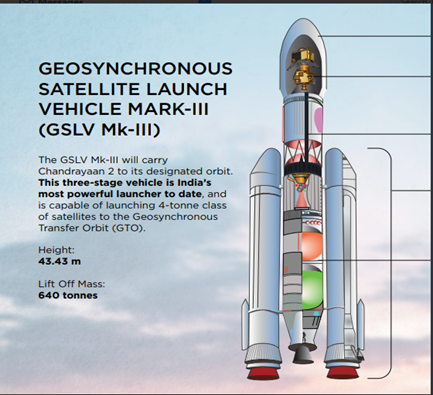
Chandrayaan-2 Mission: Updates
- The orbital insertion was achieved on 20th August 2019.
- The Orbiter has life duration of 7 years and will continue its mission.
- Vikram Lander had a mission life of 14 days.
- The landing on the moon’s surface was planned on 7th September 2019.
- However, the landing failed at the final stages.
- Vikram lander crash-landed on the moon’s surface.
- The velocity was higher than desired velocity (2 m/s).
- The Failure Analysis Committee of ISRO concluded that a software glitch was the cause of the failure.
- Pragyan Rover was planned for duration of around 14 days.
- As the landing failed, the rover could not be deployed on the moon’s surface.
- ISRO has released the data from the country’s second mission to the Moon.
- The Chandrayaan-2 data is required to be in the Planetary Data System-4 (PDS4) standard.
- It is required to be peer reviewed scientifically and technically before acceptance as PDS archives.
- It is declared to ready for sharing with the global scientific community and the general public.
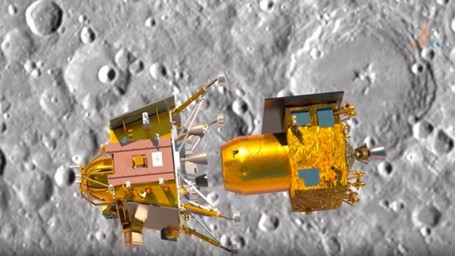
- This activity has been completed and hence the first set of data from the Chandrayaan-2 mission.
- It is now being released for the wider public use through the PRADAN portal hosted by Indian Space Science Data Centre (ISSDC).
- ISSDC is the nodal centre of planetary data archive for the planetary missions of ISRO.
- The ISRO Science Data Archive (ISDA) currently holds data sets acquired by Chandrayaan-2 payloads from September-2019 to February-2020 from seven instruments.
- ISDA is the long-term archive for ISRO planetary missions.
- India aims to become the fourth country in the world to achieve this feat, joining the ranks of the United States, Russia, and China.
- The Chandrayaan 2 mission endeavors to create a huge scientific breakthrough not only for India, but to the world as a whole.
- Despite the failure, the mission’s orbiter and other parts have been functioning normally, gathering information.
- Recently, the Indian Space Research Organisation (ISRO) released the information gathered by the scientific payloads till now.
- It is still to be analyzed and assessed.
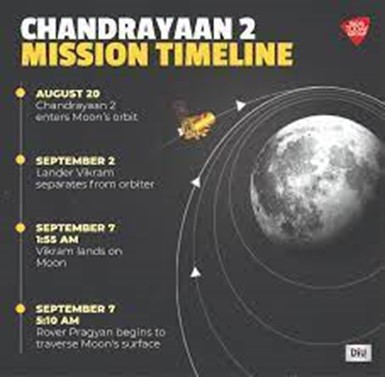
Leave a Reply
Your Comment is awaiting moderation.

